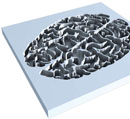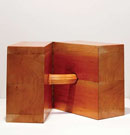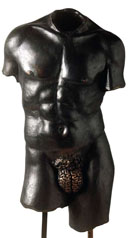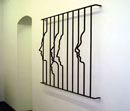Will Duchamp’s lesson never end? It always sneaks in through an unexpected place –a window, for example– when nobody expects it, just another twist on that virtually endless inspiration for art over the last hundred years. This is how a young sculptor has settled on the limelight, a young painting graduate of versatile artistic practice hailing from Cuba’s westernmost region.
His path appeared to have the same sensitivity of Los Carpinteros (The Carpenters). But as soon as he yielded his first poetic maturation, there was no doubt that Yoan Capote was clinging, among other things, to a sensuality the famous duo didn’t appraise as an expressive need. His decade-long stay down the road has paid close heed to Dada’s lessons, to surrealism, pop and minimalism, all that much sprinkled with a mighty strong instinct for materials and a concept-oriented vocation. A traditional Cuban guy, some people might say, given his uninhibited open-minded attitude toward a variety of sources.
Capote started working in the late 1990s and his pieces share certain qualities common to some renowned creators from that period of time and others that today’s reviews call Generation 00.1 What I’m referring to is that Capote quietly brandishes the sword of devil-may-care bickering over topics of identity and pertaining, two elements that have been no doubt extremely important to the island nation’s culture. He hasn’t even cared about reacting dramatically in the face of identity. He’s rather preferred to look askance at it, with a curious and condescending glance. Therefore, he drags no sense of guilt. Capote may crash a pad somewhere tonight, he’ll manage to communicate in any language and will let his charm of perseverant bavard flow out.
A typical creator formed in the hardships of the 1990s’ Cuba, this artist boasts, at this point in time, a cosmopolitism and global character that looks like easy jokes to crack. The planet is his nation; the human species is his race. And he’s taken issue with these topics under certain level of boldness, yet with composure and tranquility.
His game is quite similar to Gabriel Orozco’s: you never know for sure where the Mexican or the universal features really are. Perhaps he doesn’t care for that at all. That’s typically found, we might say, in those “new peoples” –as Ticio Escobar would put it– that can turn the pages of the age-old ascendancies and shatter the discreet little volume in which familiar genealogy fits. Capote has left the genealogical tree alone. He looks at it as a bonsai, small and beautiful, but just on a shelf at home.
The key Capote intends to open the doors and seduce the world with is sensuality. A sculptor of immense sensorial instinct, his works cannot only be watched, but also touched, listened to, tasted and even smelled. Sometimes we relate with them directly, by means of one of the senses, and some other times through a mechanism of synesthesia. But in most cases, his works are designed to stir up several senses at the same time. That’s commonplace in his exhibits, words that demand to be heard, the mysterious shape of a surface that’s rough to the touch, a particular aroma that inexorably whets our sense of smell, or an assortment of wines that’s offered to our palates. Trapped in vital mechanisms, we are at the mercy of his sybaritic intentions.
And despite both the recurrence and depth these features are deployed in his artworks, Capote is a phony epicurean. No matter how much he tempts us, no matter how much it might seem that everything is worked out in the perceptible senses, in the quenching of the desires; no matter how vehemently he attempts to show the inventiveness and splendor of his métier and how much he can seduce us with his skills, this sculptor finds his genuine roots in the analysis of men’s frames of mind.
A concealed Epicureanism is Capote’s exercise because, as a matter of fact, he always makes sure that he never reduces his interpretation of the world to what are senses are briefed about. On the contrary, the artist gets involved in thoroughly relating the many sensations with specific psychological states by giving them a concrete symbolic scope. His sculptures speak of obsession, fear, violence, paranoia, lack of communication, desire, love, longing for power, neurosis…
There are times when he takes us straight to concepts that are especially provided by the titles of their pieces. Thus, “Stress” is the shaft of a concrete pilaster in which bruxism is portrayed as the living incarnation of the human strain. He does so by underscoring the habit of gritting or grinding the teeth, just as we mortals do when we sleep during certain nights of agony. Mounted between the sections of each of the five concrete portions, whose weight resembles the rigors of life, there are four horizontal rows of human dentures cast in bronze, copies of genuine sets of teeth the artist picked up in a local dental clinic. On this square-base, sober and nearly minimal pillar, the result of some sort of collective bruxism, lies the efficient image of extreme overload, of the supportable limits, of a balance about to be broken. There’s a peculiar way of delivering both the intimate notion of stress and its many concrete expressions in just one standing piece. The fusion of these two planes –the sensorial and the conceptual– clinches the strength of this sculpture.
The most important moment in his works is when Capote projects a frame of mind in an object; the time to incarnate passion, to render a particular state of the psyche onto the concrete-sensitive plane. That’s the time when all the ingenuity of his symbolization is laid bare, his intelligence to find the key to the concept, let alone the tremendous witticism of his vision. Because, regardless of his scouring into the psyche –a common ground for introspection painting or, as seen from a different angle, the space taken by the surrealists during the exploration of the subconscious– there’s no such thing as dramatic character in his “Insanity,” “Stress,” or “Paranoia.” Passions trigger neither torments nor romanticisms. They rather draw a glimpse of pent-up emotions that blend with an analytical going, roughly flummoxing, like that of someone who can dissect about a specific topic and even make his doing fun.
It seems as if Capote somewhat modifies the surrealist tradition. Like the kid who plays with an artifact and takes it apart until it’s worthless, curious of how that gadget actually works, this artist appears to unravel the devices of an obsession or any frame of mind. He needs to know how emotions are triggered; what hormones, for instance, are released during fear or sexual arousal; what touching sensation leads us to a particular taste or what the psychophysical mechanisms of a particular form of stress are actually like. A sustained biological character present in his observation of human emotions is what really generates the neutrality of his eyesight.
Next to these sculptures, the body stands tall. Or parts of the body, prints and emanations of the body, or just the upshot of his actions: a brain in “Open Mind;” a head in “Insanity;” women on their knees in “Forbidden Park;” genitals in “Rational;” noses in “The Kiss;” hormones and neurotransmitters in “Pheromones, Endorphin,” and “Dopamine.” The body as a reflection of culture, with its own biological, psychological and social answers. The body with its physical and ethical experiences. The human body as a social body. The human body (“Mac Luhano”) with its prolongations toward the objects. Amazing sculptural anthropomorphism in the age of video!
And as far as this is concerned, Capote is by and large an artist of today. He has gotten over the modern scorn resulting from the pileup of cultural heritage; he’s moved far beyond that overzealous recurrence and helps himself from cultural memory like from any other tray in the feast. He’s also overcome the liking for popular postmodern quotations. He’s trenched at the right distance away from tradition where freedom is the name of the game. He is, in front of it, as difficultly free as it gets.
But sometimes history jumps out unexpectedly and far beyond belief during the research process of his art. As he works on “The Kiss”, made up of a number of noses cast in bronze, each and every one of them giving off specific fragrances, he was aware of the fact that Rodin was inspiring all of his efforts with his famous homonymous sculpture, a powerful appeal to passion from the rocks up. Capote’s installation would be some sort of homage to the great classic of sculpturing. However, roaming around the colonial art halls of the National Museum of Fine Arts in Havana, Capote paused for a minute before an interesting painting by Victor Patricio Landaluze2 dated in the last quarter of the 19th century. In a small painting, a black house slave leans forward, with a duster in his hand and the solitude of his masters’ bedroom as a witness, to kiss the sculpted head of a white lady. This episode, so common in the Basque painter’s customary style and derived from his slave-driving convictions, gave Capote food for thought about the social and racial connotations in the act of bussing. What started as a glimpse to Rodin’s impressionism ended up enhanced with the addition of fresh viewpoints stemming from Cuba’s traditional painting, chiefly on the basis of an analysis about the possible social, racial, anthropometric, physiological and cultural implications of a kiss.
Capote sets out into a race of reasoning and experiences that make his original project get thicker. He studies, for instance, the anatomy of Negroes, Asians, native Americans, Caucasians and others to arm himself with an array of noses that expand toward all the races. He gets equally stunned as he comes closer to the Nazi experiments in their insane quest for anthropometric patterns that could bear out the existence of a higher race at any rate. These observations led him to steer his idea of casting different nose shapes down a different course. He wanted different publics to come closer and smell the fragrances coming from hidden sponges, and he also wanted them to try a synesthesic kiss by letting them approach their noses of choice, or even letting them kiss all the noses in an act of promiscuity. To rehearse a kiss that at least once could make fun at our racial prejudices, our anthropometric phobias, our sexual inhibitions, our social disarrays.
A special kiss, indeed. A kiss that starts in the nostrils –maybe the most erotic of our senses– and goes on with a touch to the station next to it, which are the lips, only to finally anchor in the mysterious gustative cave of the mouth. A physiological buss we are all invited to. A kiss of curiosity in the rejoicing of the art gallery: a public kiss in front of the public; a performance kiss with the participation of everyone. A curious kiss that comes to pass to assess where passion begins exactly. A kiss that in the beginning was a tribute to Rodin. A kiss that along the way chanced upon Landaluze’s racial discourse and elbowed its way through the ethnic differences. A public kiss for the visiting public. An astoundingly and unexpectedly revealing kiss in terms of social behaviors. A kiss that’s eventually romantic.
Other works of his reveal a similar intervention process of the history of art. The point is that as Capote works on a piece, he looks back to what the possible contact points with certain former poetic forms could be. By doing so, the artist manages to forge a historic and conceptual affiliation for the proper interpretation of his artworks. This intention adds up subtly to the piece’s own headings, which can therefore knit ties with such remarkable sculptures as the ones made by Brancusi, Louise Bourgeois, or Cuba’s Teodoro Ramos Blanco, Kcho or Landaluze.
There are even some relationships the artist hasn’t mulled over quite consciously. It seems to go without saying, for example, that no other sculptor on the island nation since Osneldo Garcia has ever been so attached to the work with metals, so imbued in sensuality and so industrious in the making of artifacts than Capote himself. Osneldo –the top figure of Cuba’s erotic sculpturing– seems to come back into life in pieces like Traganíquel or Huéleme, in which a common sense of humor connects both creators.
There’s quite another example in one of the artist’s latest productions: the 2007 Isla series. Designed as some kind of continuation of the Sex-appeal series –it all began with fishing hooks– Capote has projected this group of painting-sculptures like a series of virtually identical marine landscapes.
Far in the distance, only seascapes, quiet and conventional seascapes, firm horizons. Seascapes that leak through the love for painting this sculptor feels. They come together in elegant frames, as good as the ones we find in renowned art galleries. They are decked out with brass plates for the headings and dates, as well as the artist’s glorious name. Seascapes comme il faut, evidement. Seascapes of tradition. Seascapes as an (unnoticed) tribute to Romañach,3 the island’s coloristic painter, a master of masters. The compound represents the same vedutta trapped in an identical atmosphere of classical painting. All the paintings keep the skyline at the same height, with similar sizes and identical techniques of oil on wood. The perfect way to gaze at these pieces will be by deploying them all over the perimeter of an art gallery with a telescope installed right in the middle. Something that would make us feel out in the sea. Something that would make us feel isolated and willing to peek into the distance.
The piece is designed to make us feel the seduction of the sea. Far in the distance you make out the landscape of the sky and the sea in the horizon. There’s nothing else in these paintings: no vessels, no people, no flags. Up close, the skies show powerful paintbrush touches, pasted and juxtaposed, light-blending and wise in their textures like the ones in a Francesco Guardi:4 the skies are hallucinating when looked at closely. In the distance the sea is steely and dark, teeming with small waves. But get closer and you’ll see a tenebrous choppy sea made up of fishing hooks. Hundreds, thousands of hooks that make up the waters, that imitate their waving, that duplicate their vibrant and unfathomable weight. When we start realizing that this is sea is a genuine mistake, that no artist is entitled to make a fool of us like that by drawing waves with iron hooks, we then start feeling the smell of the sea. The hooks have brought the illusion of the salt and as you pause for a longer look they start untying their own stories of agony, migrations and impediments. We’re just under siege by the sea and the blood-dripping hooks. Thousands of sharp hooks, painfully piercing our flesh and frightening us in that gargantuan watery and inhabited surface. The pasty, recalcitrant and dense sky looms over our heads as the perfect closer for our solitude. The piece is made to make us feel the seduction of the sea and its follies. The way in which Capote has tortured the materials by crushing the steel of the hooks over the wooden bracket underlies a sculptural and performance-like gesturing. The viewer must rub these bloody hooks, perhaps press them slightly, to feel what it would feel like if…
Around the public art, the performance and the spectator’s intervention revolve most of Yoan Capote’s works. A curious mixture for a sculptor-installer-drawer-painter. There’s profound interest in collectively rebuilding the artist’s private experience, in stepping out of the individual circle and feel with others. Also in appraising group reactions and feed on them. Because that’s part of the born-again interest in the social stuff in Cuba these days after a few years in the making. And this time around, the center has displaced from social reviews –the crux of a considerable chunk of Cuba’s contemporary art- to the experimentation of new voice-hearing, voices that speak of plurality in tones and tongues, voices that stand for the interpreted, voices that trumpet contingencies that had been unpronounceable up to now.
Seduced by the wealth of sculpturing, a hedonist devourer of classic materials, an admirer and researcher of traditional painting, builder of renowned industriousness, Capote is bound to act within the intelligence boundaries of Cuba’s artistic framework. And for driving a wedge of his own into the human pathways a road that comprises the odd and always stunning blend of psyche and biology, that blend that puts men of all races and of all tongues on equal footing. The universality of his artworks is guaranteed in our conscious psychobiological unit.
But Capote cannot speak out at length on a new form of romanticism or in unsustainable classicisms, and practice that traditional art he looks up at so much. There won’t be for sure Romañach’s seascapes the heralds of today’s racial comments. Capote must prove he masters that tradition, he can put up with it, place it subliminally in his pieces or turn them into reservoirs of slight insolences. Moreover, Capote must also count on the viewers, turning his experience inside out. Because that experiences and the spectator’s voice are the ones that have raised the artistic bar in today’s Cuba. The artist does trust a good deal in his strength to address everybody, to show people his Open Mind or give them a new redo of The Garden of Delights in which –this time up is for sure– we rationally pledge not to get carried away with the traps our senses set us up with.
Havana, July 2008





Previous publication A Shock in the Paradise of Symbol
Next publication Cildo Meireles. Against hegemonic ideas in art
Related Publications

How Harumi Yamaguchi invented the modern woman in Japan
March 16, 2022
Giovanni Duarte and an orchestra capable of everything
August 26, 2020











